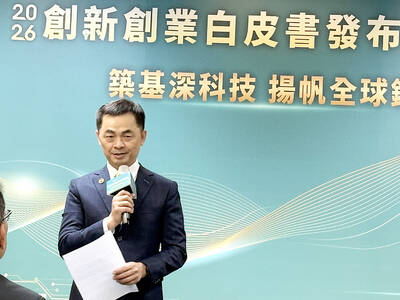With private consumption lethargic and excessive savings expected to hit a two-decade high next year, the chief government economic planner is to talk with retailers this week to gain a better grasp of why consumers refuse to spend.
On Friday, Council for Economic Planning and Development Chairman Chen Tian-jy (陳添枝) telephoned General Chamber of Commerce (全國商業總會) chairman Chang Ping-chao (張平沼), asking him to arrange meetings with grocers and retailers this week to help the council find remedies to reverse slumping consumer confidence.
The Directorate-General of Budget, Accounting and Statistics (DGBAS) recently lowered the GDP growth forecast for the second quarter from 4.57 percent to 4.32 percent and attributed the trim mainly to weaker-than-expected domestic demand.
Domestic demand posted a decline of 1.72 percent between April and June, sinking GDP by 1.46 percentage points, the DGBAS report showed. Food spending reported a drop of 1.87 percent, while private investment and capital equipment imports fell 9.37 percent and 12.7 percent respectively, the report said.
Chang told reporters he would try his best to arrange the meetings before Thursday.
Chen’s move marked yet another government effort to pull the economy out of the doldrums after cyclical business indicators flashed a slowdown signal in July with withering domestic demand blamed for the trend.
A report by the Ministry of Economic Affairs released on Aug. 22 showed that the retail sector suffered a 3.81 percent decline in business volume year-on-year last month, and the drop is expected to deepen in the coming months on sustained inflationary pressures.
Norman Yin (殷乃平), a professor of money and banking at National Chengchi University, said consumers would continue to refrain from spending as long as their incomes remain unchanged and commodity prices keep rising.
Yin predicted that the inflation rate would exceed 4 percent this year although the DGBAS put the figure at 3.74 percent.
The sense of insecurity has prompted people to keep their money in the bank. The DGBAS projected that the national savings rate would reach 30.6 percent next year while the excess savings rate would hit NT$1.3 trillion (US$41.3 billion), a ratio of 9.5 percent to GDP, both the highest since 1989.
Excess savings have hit NT$1.1 trillion, or a rate of 8.5 percent, this year, based on the DGBAS data, which has prompted the central bank to use public market operations and various instruments to absorb this huge glut of idle funds from the money markets.
Economists have said that the key to resolving the problem of excess savings is how the government boosts domestic investment and private consumption.
This has become a more urgent task for Taiwan in the second half of the year as the country is facing weakening demand of its exports because of the global slowdown. The government’s latest data showed on Aug. 25 that export orders grew 5.52 percent year-on-year in July and marked the slowest pace since May 2003.
Kevin Hsiao (蕭正義), head of UBS Wealth Management Research in Taiwan, said it is unhealthy for an economy to draw its growth from exports alone as that makes it susceptible to external influences.
“Heavy dependence on exports leaves Taiwan ill equipped in coping with surging fuel and raw material costs that are eroding corporate profits and the nation’s economic performance,” Hsiao said.

CHIP RACE: Three years of overbroad export controls drove foreign competitors to pursue their own AI chips, and ‘cost US taxpayers billions of dollars,’ Nvidia said China has figured out the US strategy for allowing it to buy Nvidia Corp’s H200s and is rejecting the artificial intelligence (AI) chip in favor of domestically developed semiconductors, White House AI adviser David Sacks said, citing news reports. US President Donald Trump on Monday said that he would allow shipments of Nvidia’s H200 chips to China, part of an administration effort backed by Sacks to challenge Chinese tech champions such as Huawei Technologies Co (華為) by bringing US competition to their home market. On Friday, Sacks signaled that he was uncertain about whether that approach would work. “They’re rejecting our chips,” Sacks

NATIONAL SECURITY: Intel’s testing of ACM tools despite US government control ‘highlights egregious gaps in US technology protection policies,’ a former official said Chipmaker Intel Corp has tested chipmaking tools this year from a toolmaker with deep roots in China and two overseas units that were targeted by US sanctions, according to two sources with direct knowledge of the matter. Intel, which fended off calls for its CEO’s resignation from US President Donald Trump in August over his alleged ties to China, got the tools from ACM Research Inc, a Fremont, California-based producer of chipmaking equipment. Two of ACM’s units, based in Shanghai and South Korea, were among a number of firms barred last year from receiving US technology over claims they have

BARRIERS: Gudeng’s chairman said it was unlikely that the US could replicate Taiwan’s science parks in Arizona, given its strict immigration policies and cultural differences Gudeng Precision Industrial Co (家登), which supplies wafer pods to the world’s major semiconductor firms, yesterday said it is in no rush to set up production in the US due to high costs. The company supplies its customers through a warehouse in Arizona jointly operated by TSS Holdings Ltd (德鑫控股), a joint holding of Gudeng and 17 Taiwanese firms in the semiconductor supply chain, including specialty plastic compounds producer Nytex Composites Co (耐特) and automated material handling system supplier Symtek Automation Asia Co (迅得). While the company has long been exploring the feasibility of setting up production in the US to address

OPTION: Uber said it could provide higher pay for batch trips, if incentives for batching is not removed entirely, as the latter would force it to pass on the costs to consumers Uber Technologies Inc yesterday warned that proposed restrictions on batching orders and minimum wages could prompt a NT$20 delivery fee increase in Taiwan, as lower efficiency would drive up costs. Uber CEO Dara Khosrowshahi made the remarks yesterday during his visit to Taiwan. He is on a multileg trip to the region, which includes stops in South Korea and Japan. His visit coincided the release last month of the Ministry of Labor’s draft bill on the delivery sector, which aims to safeguard delivery workers’ rights and improve their welfare. The ministry set the minimum pay for local food delivery drivers at